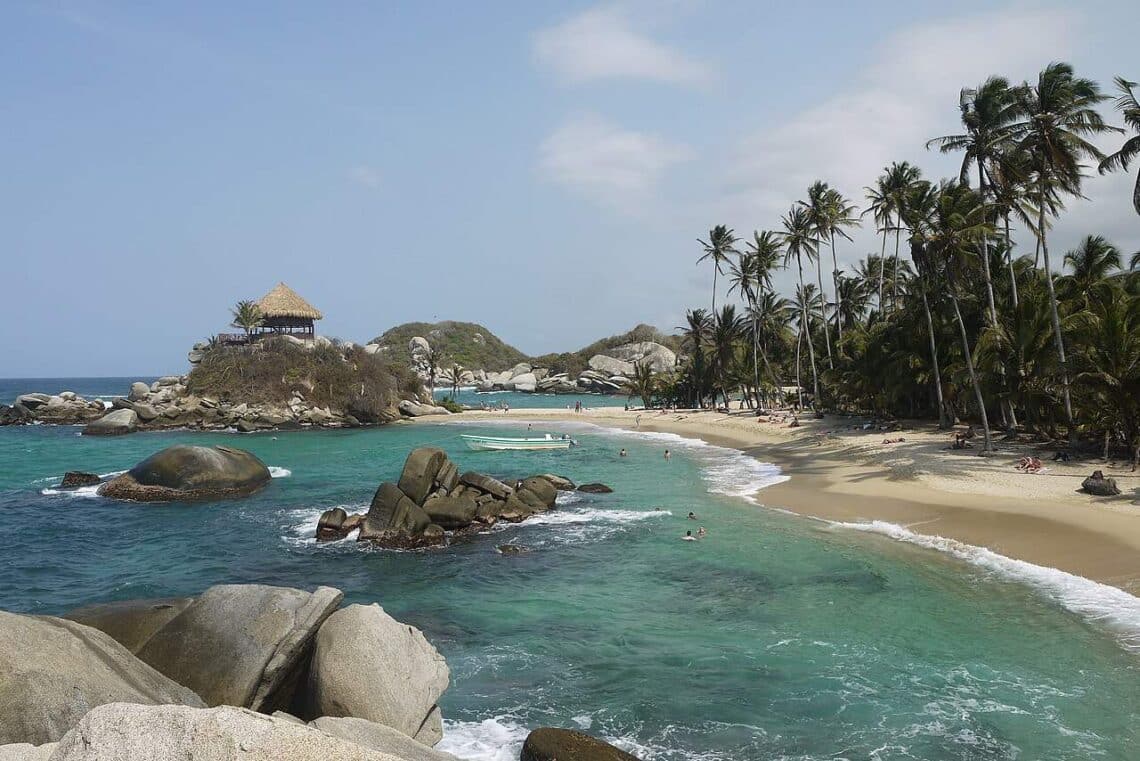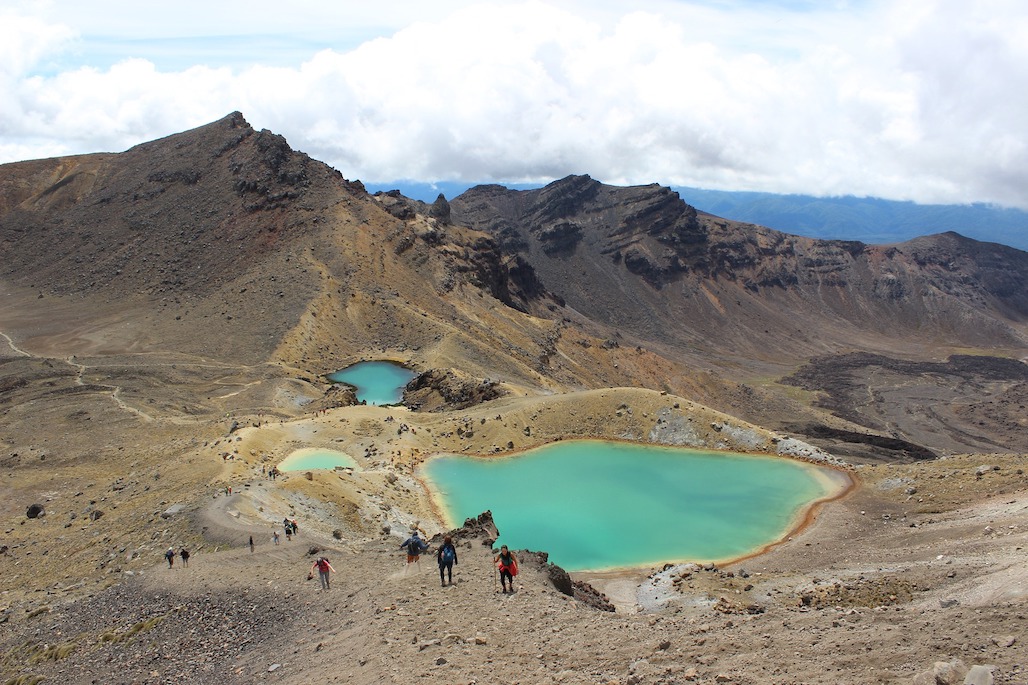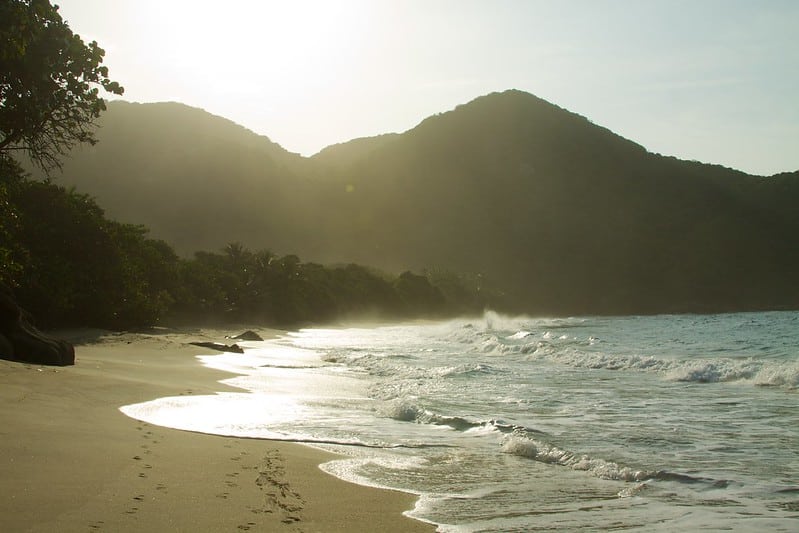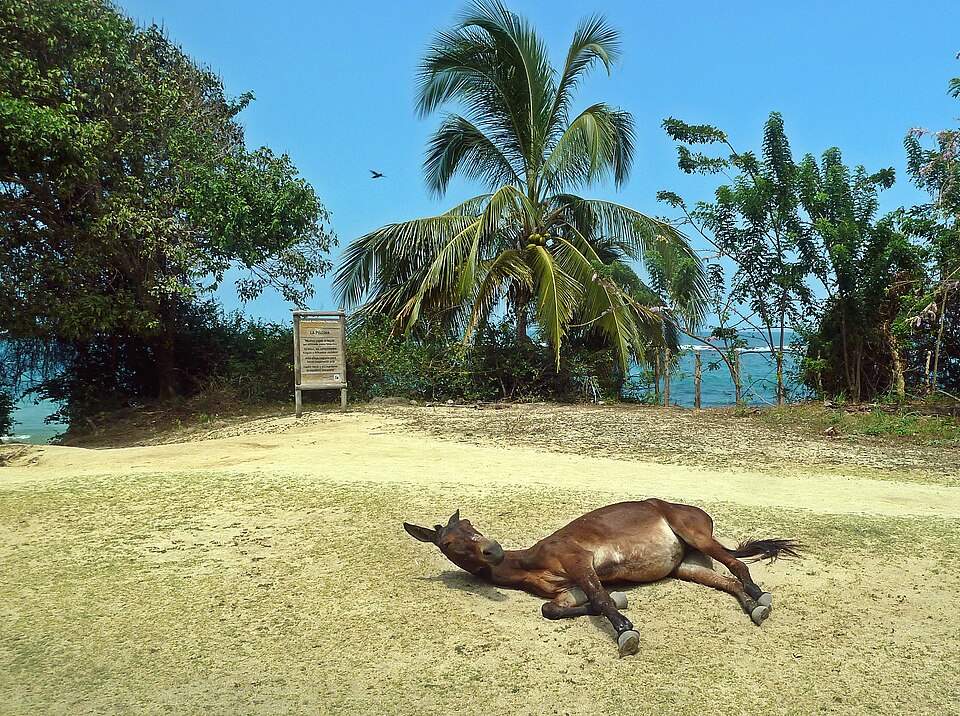
Complete Guide to Tayrona National Park Beaches: Where to Go and What to Know
Understanding Tayrona National Park
Before we dive into the beaches themselves, let’s get the lay of the land. Tayrona National Park (Parque Nacional Natural Tayrona) sits about 34 kilometers north of Santa Marta along Colombia’s Caribbean coast. The park protects around 15,000 hectares of land and 3,000 hectares of ocean, creating this incredible ecosystem where tropical rainforest meets coral reefs.
The indigenous Tayrona people originally inhabited this region, and their descendants—the Kogi, Arhuaco, Wiwa, and Kankuamo communities—still consider much of this land sacred. You’ll occasionally see Kogi families along the trails, sometimes selling fresh juice or handmade crafts. It’s a gentle reminder that this isn’t just a tourist destination but a living cultural landscape.
What makes Tayrona unique is how it forces you to slow down. There are no roads winding along the coast, no beachfront hotels lining the shore. Just trails through the jungle, occasional camping areas, and beaches that appear almost magically as you round each bend. For a broader look at all coastal options in the region, check out our complete guide to Santa Marta beaches.
Entrance Fees and Practical Information
Current Entry Costs (2025)
Let’s talk money first, because understanding the costs helps with planning. Tayrona’s entrance fees vary based on season and residency status. Here’s the breakdown for 2025:
High Season (December 15-January 30, June 15-July 15, Holy Week, and long weekends):
- Foreign tourists: 87,000-92,000 COP (approximately $22-$23 USD)
- Colombian residents over 25: 39,000-41,000 COP
- Colombian residents under 25: 27,500-29,000 COP
- Mandatory insurance: 6,000-7,000 COP (cash only)
Low Season (all other dates):
- Foreign tourists: 73,500-77,500 COP (approximately $18-$19 USD)
- Colombian residents over 25: 33,000-35,000 COP
- Colombian residents under 25: 24,500-26,000 COP
- Mandatory insurance: 6,000-7,000 COP (cash only)
A couple of things worth noting here. First, you’ll need your physical passport to purchase the entrance ticket—no photocopies or phone photos. Second, that mandatory insurance fee must be paid in cash, even though the entrance fee itself can usually be paid by card. They’ll give you a wristband that you need to wear for your entire stay, with your entry and exit dates written on it.
Your ticket is valid for multiple days if you’re camping inside the park, which is honestly one of the best deals going. Pay once, stay as long as your camping reservation allows.
Park Entrances
Tayrona has four main entrances, but El Zaino is by far the most popular and gives you access to the iconic beaches like Cabo San Juan and La Piscina. The other entrances are Calabazo (used for alternative trekking routes), Palangana, and Bahía Concha (which is technically separate and has different, lower entrance fees).
From Santa Marta’s main bus terminal, you can catch a bus directly to El Zaino entrance for about 9,000 COP. Buses start running around 7:00 AM, and the ride takes roughly 30-40 minutes. Getting there early matters—trust me on this. The earlier you start, the cooler the hike and the emptier the trails.
Important Closure Dates
Here’s something that catches visitors off guard: Tayrona closes for several weeks each year for environmental recovery. These closures typically happen in February and again around October/November, but the exact dates change annually. Always check the official park website or call ahead before finalizing your plans. Nothing’s worse than showing up to a closed park.
The Main Beaches of Tayrona
Cabo San Juan: The Crown Jewel
Let’s start with the beach that probably brought you here in the first place. Cabo San Juan del Guía—everyone just calls it Cabo San Juan—is the postcard-perfect spot with those iconic cabañas perched on a rocky outcrop. Two small bays separated by dramatic rocks, both swimmable, both absolutely gorgeous.
The beach itself wraps around in this beautiful horseshoe shape, with calm Caribbean waters that invite you in. Unlike some other Tayrona beaches where swimming is prohibited due to dangerous currents, Cabo San Juan’s protected bays make it safe for a dip. I’ve seen people snorkeling around the rocks, though the visibility depends heavily on recent weather and wave action.
What makes Cabo San Juan special isn’t just the scenery—it’s the vibe. There’s this relaxed, communal atmosphere with travelers from all over hanging out, swapping stories, sharing meals from the simple restaurant on site. The camping area sits right behind the beach, so you can literally roll out of your tent and onto the sand.
Getting there requires about a 2-hour hike from El Zaino entrance (or 1.5 hours if you’re moving fast). The trail is well-marked and mostly shaded, winding through jungle and past other beaches before finally revealing Cabo San Juan in all its glory. That first glimpse as you come around the bend? Yeah, it hits different.
For detailed camping information and booking tips, our where to stay in Santa Marta guide covers accommodation options both inside and outside the park.
La Piscina: The Swimming Spot
About 10 minutes before you reach Cabo San Juan, you’ll pass La Piscina—and perhaps the name gives it away. “The Pool” earned its nickname from the naturally calm, protected waters that feel almost like a giant swimming pool carved by nature.
This is the beach where families tend to congregate, where nervous swimmers feel comfortable, where you can actually relax in the water without constantly fighting waves or currents. The beach is smaller than Cabo San Juan, more of an intimate cove really, but what it lacks in size it makes up for in swimmability.
La Piscina also serves as a popular snorkeling spot. The rocky areas harbor tropical fish, small coral formations, and if you’re lucky, sea turtles cruising by. The water clarity here tends to be better than at other beaches, making it easier to actually see the marine life. Many snorkeling tours operating in the area include La Piscina as a stop—you can learn more about tour options in our guide to snorkeling in Santa Marta.
There’s no camping at La Piscina itself, but it’s close enough to Cabo San Juan that you can easily walk over. Most people stop here for a swim on their way to or from Cabo San Juan, treating it as a refreshing pitstop rather than a final destination.
Arrecifes: Beautiful But Dangerous
Arrecifes is the first major beach you’ll encounter on the hike from El Zaino, appearing after about an hour of walking. It’s stunningly beautiful with its wide stretch of golden sand, powerful waves crashing against the shore, and dramatic rock formations dotting the coastline.
Here’s the critical part: do not swim at Arrecifes. The name literally means “reefs,” and the combination of strong currents, riptides, and rocky underwater formations makes swimming extremely dangerous. People have drowned here, and the park rangers will tell you firmly—look, photograph, enjoy the view, but stay out of the water.
That said, Arrecifes serves as an important camping zone with decent facilities including a restaurant, bathrooms, and multiple camping areas. It’s actually closer to the entrance than Cabo San Juan, making it a good option if you want to minimize hiking time or if you’re carrying heavy gear.
The beach is also where you’ll find that Kogi vendor selling fresh orange juice—honestly one of the highlights of the entire hike. Cold, tart, perfectly refreshing at exactly the moment you need it most.
Playa Cinto: The Remote Beauty
Cinto Beach represents the road less traveled in Tayrona. Accessible either by continuing past Cabo San Juan on foot or by boat from nearby beaches, Cinto remains quieter and more secluded than its famous neighbors.
The beach itself stretches longer than Cabo San Juan, with softer sand and fewer rocks. Swimming conditions vary—sometimes the waters are calm and inviting, other times they’re rougher and require caution. There’s less infrastructure here, fewer people, more of that castaway feeling that some travelers crave.
Getting to Cinto requires commitment. If you’re hiking from Cabo San Juan, add another 45 minutes to an hour. The trail gets less maintained, more adventurous, definitely not recommended if you’re already exhausted from the main hike. Some visitors opt to take a boat from nearby beaches instead, which cuts down on hiking time considerably. Check our Santa Marta boat tours guide for water transportation options.
Limited camping facilities exist at Cinto, though it’s more rustic than what you’ll find at Cabo San Juan or Arrecifes. This is for travelers who truly want to escape the crowds and don’t mind sacrificing some convenience for solitude.
Nudist Beach (Playa Brava)
About a 20-minute walk past Cabo San Juan lies Colombia’s only official nudist beach. Playa Brava maintains a clothing-optional policy, attracting a specific crowd of travelers looking for that au naturel beach experience.
The beach itself is pretty, though swimming here requires caution as the waves can be strong. It’s smaller and more intimate than the main beaches, with fewer facilities—basically just sand, surf, and nature. The nudist beach culture here feels relaxed and non-judgmental, though obviously it’s not everyone’s cup of tea.
If you’re curious but not committed, the walk from Cabo San Juan is short enough that you can check it out and return without major time investment. Just remember that if you do visit, respecting the local norms means either going fully nude or at minimum being very comfortable with those around you who are.
Bahía Concha: The Separate Sector
Technically part of Tayrona but accessed separately, Bahía Concha operates almost like its own entity. The entrance fees are lower (around 25,000-41,000 COP), and you can drive directly to the beach area without the extensive hiking required at other Tayrona beaches.
This makes Bahía Concha particularly popular with families, older visitors, or anyone who wants the Tayrona experience without the two-hour trek. The beach stretches wide and beautiful, with calmer waters suitable for swimming and several beachfront restaurants serving fresh seafood.
The trade-off is atmosphere. Bahía Concha feels more developed, less wild, somewhat disconnected from the jungle-meets-ocean vibe that defines the rest of Tayrona. It’s still lovely, just different. Think of it as Tayrona-lite—same park system, easier access, slightly different character.
Hiking Routes and Trail Information
The Main Trail: El Zaino to Cabo San Juan
The classic Tayrona experience follows this route, and it’s what most visitors come for. After entering at El Zaino, you can either start hiking immediately or take the internal shuttle (5,000 COP) to Cañaveral, which saves about 45 minutes of walking. I’d recommend taking the shuttle—it saves your energy for the better parts of the trail.
From Cañaveral, the trail winds through dense jungle for the first 30-40 minutes. The path alternates between wooden boardwalks, dirt trails, and occasional rocky sections. It’s well-maintained and clearly marked, so getting lost isn’t really a concern unless you deliberately wander off trail.
You’ll reach Arrecifes first, then La Piscina, and finally Cabo San Juan. The total hiking time runs about 1.5 to 2 hours depending on pace, fitness level, and how often you stop for photos or water breaks. The trail isn’t particularly steep, but the humidity makes everything feel harder than it looks on paper.
Here’s what to bring: plenty of water (at least 2 liters per person), sunscreen, insect repellent, snacks, and proper walking shoes. Flip-flops might be fine for the beach, but you’ll regret wearing them on the hike. Keep your good shoes on during the trek, then switch to sandals once you reach your destination.
Alternative Route: Calabazo Entrance
For a completely different Tayrona experience, some adventurous travelers enter through Calabazo on the park’s eastern edge. This route is longer, more challenging, and sees far fewer tourists—which is exactly why certain people love it.
The Calabazo trek typically takes 2 days, often includes an overnight stay in Playa Brava or other camping areas, and passes through more remote sections of the park. You’ll encounter indigenous Kogi communities, walk through pristine jungle sections, and experience Tayrona in a way that day-trippers never see.
This route requires better fitness, more preparation, and ideally a guide who knows the trails. It’s not for everyone, but if you have the time and inclination, it offers a much deeper, more immersive Tayrona experience.
Trail Conditions and Safety
The trails themselves are generally safe and well-maintained. Park rangers patrol regularly, and you’ll encounter other hikers throughout the day. That said, a few safety considerations matter:
- Start early to avoid the worst heat and ensure you finish before the park closes
- Stay on marked trails—wandering into the jungle can be genuinely dangerous
- Don’t hike alone if possible; there have been rare reports of theft on isolated trail sections
- Watch for falling coconuts, especially near beach areas (this sounds funny but people do get injured)
- Respect all swimming restriction signs—they exist for good reason
The park officially closes around 5:00 PM, meaning you need to start your return hike with enough time to exit before closure. Rangers do enforce this, and getting caught in the jungle after dark would be unpleasant at best.
Camping in Tayrona National Park
Camping at Cabo San Juan
Cabo San Juan offers the most sought-after camping experience in Tayrona, with several accommodation options to choose from. Booking ahead is essential, especially during high season when spaces fill up weeks in advance.
Your options include:
- Hammocks: 40,000-60,000 COP per person. The prime spots are on the mirador tower where you’ll catch ocean breezes. No mosquito nets provided, so bring repellent.
- Bringing your own tent: Around 30,000 COP for the camping spot. You provide all your own gear.
- Renting a tent: 70,000-150,000 COP depending on size and season. Basic structures with mattresses on wooden platforms. Don’t expect luxury—think functional camping with a roof.
- Cabañas: 250,000-400,000 COP. More solid structures with better beds, but still pretty basic by hotel standards.
To book Cabo San Juan camping, you’ll need to message them via WhatsApp at +573112589907. The booking process can be a bit slow and communication isn’t always smooth, but persistence pays off. Book at least 2-3 weeks ahead during high season, maybe a week ahead during low season.
Facilities at Cabo San Juan include cold-water showers (actually refreshing in the heat), basic bathrooms, and a simple restaurant serving meals throughout the day. The restaurant isn’t fancy—think rice, chicken, fish, and basic vegetarian options—but after a day of hiking and swimming, everything tastes pretty good. Prices are higher than outside the park, naturally, with meals running 20,000-35,000 COP.
Camping at Arrecifes
The Arrecifes sector offers another camping option, operated by different concessionaires. It’s closer to the entrance, making it logistically easier if you’re carrying heavy gear or have limited hiking ability.
Camping costs run similar to Cabo San Juan—hammocks, tent rentals, and cabins in comparable price ranges. The facilities here include a larger restaurant with more menu options, decent bathrooms, and camping areas spread across a wider zone.
The main drawback is that you can’t swim at Arrecifes beach itself due to dangerous conditions. You’ll need to walk to La Piscina or Cabo San Juan for safe swimming, which means additional hiking. For some visitors this works fine, especially if they arrive late and just need a place to sleep before exploring the next day.
What to Bring for Camping
Whether you’re renting accommodation or bringing your own tent, certain items make the experience much better:
- Headlamp or flashlight (the camping areas get properly dark at night)
- Insect repellent (mosquitoes are relentless, especially at dawn and dusk)
- Quick-dry towel
- Sunscreen and after-sun lotion
- Reusable water bottle (you can refill at restaurants)
- Small first aid kit with basics like bandaids and pain relievers
- Waterproof bag for electronics and valuables
- Snacks for the trail and emergency munchies
- Biodegradable toiletries
- Cash (there are no ATMs inside the park)
Leave unnecessary valuables at your accommodation in Santa Marta. While theft isn’t rampant in Tayrona, it does happen occasionally, and there’s no reason to bring expensive jewelry or extra electronics into the jungle.
Best Time to Visit Tayrona
Weather Patterns
Tayrona sits in the tropics, meaning warm temperatures year-round with average highs around 28-32°C (82-90°F). But rainfall varies significantly throughout the year, which affects trail conditions, visibility for snorkeling, and overall comfort.
The driest months run from December through March and again in July-August. These are considered high season for good reason—less rain means clearer skies, calmer seas, and more comfortable hiking. The ocean visibility tends to be better during these months too, making it prime time for snorkeling.
April-May and September-November bring more rainfall. The park doesn’t become impassable or anything dramatic, but trails can get muddier, humidity feels even more oppressive, and you’ll likely encounter rain showers during your visit. Some people actually prefer these months for the smaller crowds and lusher jungle scenery.
Crowd Considerations
High season means more visitors, plain and simple. Cabo San Juan can feel genuinely crowded during peak December-January and Holy Week periods, with beach space at a premium and camping areas fully booked.
If you’re seeking solitude and don’t mind occasional rain, visiting in shoulder season (April-May, September-October) offers a nice middle ground. You’ll share the trails with fewer people while still maintaining decent weather odds. Just double-check that the park isn’t closed for its annual recovery period.
Weekends see more Colombian visitors than weekdays, particularly long holiday weekends when locals have time for multi-day trips. If your schedule allows flexibility, plan for midweek arrivals when possible.
Sunrise and Sunset
One underrated aspect of camping in Tayrona is experiencing sunrise from the beach. Most day-trippers haven’t arrived yet, the light is magical, and you essentially have these spectacular beaches to yourself for a couple hours. Cabo San Juan facing east catches beautiful sunrise views, while the mirador lookout point offers 360-degree perspectives.
Sunset is trickier since the park closes relatively early. Day visitors need to start heading out by 3:00 PM to exit before closure, missing the golden hour entirely. Campers win here, able to enjoy evening beach time without worrying about hiking out in darkness.
Day Trip vs. Overnight: Which is Better?
This question comes up constantly, and honestly, there’s no universal right answer. It depends on your priorities, fitness level, budget, and schedule.
Day Trip Benefits:
- Less expensive (just entrance fees plus transportation)
- Lighter packing—just bring day-trip essentials
- Sleep in a more comfortable bed in Santa Marta
- Easy access to restaurants, pharmacies, and other city conveniences
Day Trip Drawbacks:
- Rushed experience—hiking in and out plus beach time gets tight
- Miss sunrise and early morning beach serenity
- More crowded beach experience during peak day-visitor hours
- No opportunity to explore multiple beaches leisurely
Overnight Benefits:
- Fully immersive jungle-beach experience
- Access to beaches at sunrise when they’re nearly empty
- Time to explore multiple beaches without rushing
- That special feeling of sleeping steps from the Caribbean
- Get to enjoy the communal camping atmosphere
Overnight Drawbacks:
- More expensive (camping costs add up)
- Basic facilities—no hot showers, limited food options
- Humidity makes sleeping uncomfortable for some
- Need to carry more gear or pay rental fees
My take? If you have the time and budget, stay at least one night. The day-trip experience feels rushed, and you miss out on what makes Tayrona truly special—that early morning magic, the star-filled nights, the rhythm of waking up to waves instead of traffic. But if your schedule or budget doesn’t allow, a well-planned day trip still offers a gorgeous taste of what Tayrona provides.
What Else to Know Before You Go
Food and Water
Restaurants exist at major camping areas, but menu options stay pretty limited and prices run high by Colombian standards. Expect to pay 20,000-40,000 COP for basic meals. The food is decent enough—fresh fish, chicken, rice, beans, sometimes pasta—but don’t expect culinary adventures.
Bringing your own snacks and food is allowed and smart, especially if you have dietary restrictions or particular preferences. Just remember you’ll need to carry everything in and pack out all trash. The park enforces strict no-littering policies, and you’ll see rangers checking bags on the way out.
Water is available at restaurants for refilling bottles, typically treated and safe to drink. Some people prefer bringing water purification tablets or a filter as backup. Either way, don’t skimp on water—the heat and humidity demand constant hydration.
Wildlife Encounters
Tayrona supports incredible biodiversity. You’ll likely see howler monkeys swinging through trees, lizards of various sizes sunning on rocks, countless bird species, and if you’re lucky, maybe a sloth hanging motionless in the canopy.
Marine life includes tropical fish, occasional sea turtles, and in deeper waters beyond the beaches, rays and small sharks. The coral reefs here aren’t as extensive as other Caribbean destinations, but they host enough life to make snorkeling worthwhile. For more detailed snorkeling information, including what species you might encounter, check our complete snorkeling guide.
Please don’t feed wildlife, no matter how tempting. Monkeys especially can become aggressive when habituated to human food, and it disrupts their natural feeding patterns.
Environmental Considerations
Tayrona operates as a protected national park for good reason. The ecosystems here are fragile and increasingly under pressure from tourism. As visitors, we have a responsibility to minimize our impact:
- Use only reef-safe, biodegradable sunscreen (regular sunscreen damages coral reefs)
- Pack out all trash, including cigarette butts and food wrappers
- Stay on designated trails to prevent erosion
- Don’t touch or remove coral, shells, or any marine life
- Respect wildlife viewing distances
- Use provided bathrooms rather than going in the jungle
- Minimize noise pollution—let nature’s sounds take center stage
The annual park closures exist to allow ecosystems to recover from visitor impact. These closures work, which is why Tayrona remains as beautiful as it is. Supporting these conservation efforts through responsible behavior ensures the park stays protected for future generations.
Connectivity and Communication
Cell phone service inside Tayrona is spotty at best and non-existent in most areas. Some spots near entrances or camping areas might catch weak signals, but don’t count on it. This digital disconnection is actually part of the appeal for many visitors—a forced break from constant connectivity.
Let people know you’ll be offline before entering the park. There’s no WiFi at camping areas, no way to post real-time Instagram updates, no ability to respond to work emails. It’s just you, nature, and the other travelers around you. Embrace it.
Combining Tayrona with Other Santa Marta Beaches
Tayrona represents just one facet of Santa Marta’s incredible coastal offerings. While it provides that pristine jungle-beach experience, other beaches in the area offer different vibes and advantages.
Playa Cristal, for instance, sits technically within Tayrona boundaries but requires boat access, offering some of the clearest waters for snorkeling without the extensive hiking. Our Playa Cristal guide covers how to visit this gem and whether it’s worth the hype.
El Rodadero, on the other hand, provides easy beach access right from Santa Marta with family-friendly facilities and infrastructure that Tayrona intentionally lacks. If you’re traveling with young children or older family members who can’t manage the Tayrona hike, beaches like El Rodadero offer easier alternatives. Check our El Rodadero beach guide for more information.
A well-rounded Santa Marta beach experience might include Tayrona for that wild, pristine nature fix, plus a few other beaches that offer different experiences. Mixing adventurous days with easier beach lounging creates nice balance, especially on longer trips. For the complete overview of all beach options, our Santa Marta beaches guide helps you plan the perfect mix.
Final Thoughts
Tayrona National Park beaches deliver something increasingly rare—a Caribbean coastline that still feels genuinely wild and protected. Yes, it requires effort. Yes, the camping is basic. Yes, you’ll sweat through your shirt on the hike in. But that’s exactly what creates the magic.
These beaches aren’t packaged and polished for easy consumption. They demand something from visitors—physical effort, mental presence, respect for nature and indigenous territories. In return, they offer experiences that feel authentic and earned, with sunrise views that money can’t buy and swimming spots that haven’t been ruined by overdevelopment.
Go with realistic expectations. Understand that it’s going to be hot, humid, sometimes uncomfortable. Bring proper supplies, respect the rules, leave no trace. Allow enough time to actually enjoy rather than just check boxes. And maybe, just maybe, stay for that sunrise—that moment when Cabo San Juan reveals itself in golden morning light with only a handful of fellow campers sharing the view.
That’s Tayrona at its best. Wild, beautiful, worth every step of the hike.
You May Also Like

China – Large Tourist Country
May 26, 2015
Top Historic Cafes in Europe
September 15, 2015





